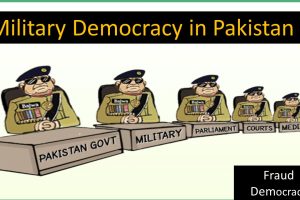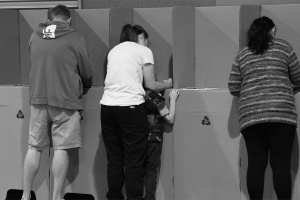By Syed Atiq ul Hassan, Sydney, Australia.
In Australia, federal elections are held every three years. Casting vote in an election is mandatory for all Australian citizens. Scott Morrison, the Prime Minister, has announced it will be held on Saturday, May 21, 2022. In Australia, there are 49 national parties registered, but only two parties dominate national politics, and Australian voters are also focused on only these two parties and their manifestos for the public and the country.

The Liberal Party of Australia, the Australian Labor Party (ALP), the Australian Greens, the National Party of Australia (NPA), and One Nation are actively campaigning in the federal election to win the electoral support of Australians for the next four years. Labor and Liberal are the only two parties that are popular in every state in Australia. These parties are the oldest and most powerful political forces in Australia. The Labor party is 120 years old party that was formed on 8 May 1901 in Melbourne, whereas the Liberal Party was formed on 16 October 1944 in Canberra.
The National Party of Australia (NPA) is also over 100 years old. It was founded in 1920 as Australian Country Party, then changed to National Country Party in 1975, and then adopted the name National Party of Australia in 1982. The current leader of the National Party is Barnaby Joyce, who was re-elected leader following three years of Michael McCormack. This party represents Australian farmers and graziers; therefore, it is popular in rural and regional areas. Traditionally, the National Party holds an alliance with the Liberal Party.
In 1992, the Australian Green party was founded by the former legendary Tasmanian politician, doctor, and environmentalist, Mr. Bob Brown. The Green Party advocates for a safe environment, social justice, antiwar, and anti-racism. The Green Party traditionally works with Labor or Liberal based on the results of the federal election and seats secured by the parties.
Due to the dominance of the Liberal and Labor parties in national politics, as either one remains in power, the Australian public focuses on the election manifesto of these two parties and selects one for voting in the federal election.
Labor and Liberal parties also dominate politics in different states, but federal politics are separate from state-level politics. In other words, Labor or Liberal may hold the government in a certain state but may not necessarily win the federal election in that state for the same reason. Labor currently controls the government in Victoria, and the Liberals rule in New South Wales, but Australians will vote in the federal election for Labor or Liberal depending on whose manifesto they like best on federal issues.
In general, both Labor and Liberal are focusing their election agendas on common issues faced by Australians. These issues include the national economy, health, education, childcare, social services, industrial relations, facilities for farmers and graziers, employment, and future migration policy.
53 years old Scott Morrison is currently the 30th Prime Minister of Australia and represents the ruling Liberal Party. He was born in Sydney to a Christian family. Scott’s father was a police chief inspector and independent politician who served 16 years for the local council and as mayor of Waverley (Sydney).
Currently, the Australian Labor Party is led by 59-year-old Anthony Albanese. He was also born and raised in Sydney. Albanese has served as a leader of the opposition, Labor party, in the Australian parliament since 2019.
Anthony Albanese announced Labor’s election agenda for the coming election, identifying the following as its key issues and offers:
- Make it easier for Medicare recipients to see doctors. Having Medicare Urgent Care Clinics will make it easier for Australian families to see a doctor or nurse when they have an urgent. Medicare Urgent Care Clinics will bulk bill, so there will be no out-of-pocket expenses.
- Increase the number of university and TAFE places and make jobs more secure with better pay and conditions by investing in Fee-Free TAFE.
- There will be 465,000 fee-free TAFE places for Australian students studying in industries with a skills shortage, including 45,000 new places.
- 20,000 extra university places over 2022 and 2023, making it easier for Australians to find a spot at university and get a job.
- Review minimum wages of employees and labour due to the increase in daily use items and housing prices.
- Make childcare cheaper and easier for working families. Lift the maximum childcare subsidy rate to 90 percent for families for the first child in care, increase childcare subsidy rates for every family with one child in care earning less than $530,000 in household income, keep higher childcare subsidy rates for the second and additional children in care and extend the increased subsidy to outside school hours care. As a result, 96 percent of Australian families will be better off under Labor’s childcare reforms.
Labor’s agenda is not extraordinary and consists of routine benevolence rather than anything ground-breaking. Is this agenda attractive to the common Australians? Only time will tell on the election day.
The Liberal’s manifesto, announced by the Prime Minister, Scott Morrison basically talks about the same issue with no fundamental differences. The key points of Liberal’s agenda are:
- More jobs, with unemployment below 4 percent.
- Tax relief for workers and small businesses.
- Record investment in health and other essential services.
- Better roads and cleaner energy
- And stronger defence, borders, and security
- invest $106.6 million to establish a National Institute for Forest Products Innovation, with a central hub in Launceston and up to five centers of excellence around Australia
- deliver $112.9 million in grants to accelerate the adoption of new wood processing technologies
- invest $86.2 million in a new Plantation Establishment Program
- invest $4.4 million to strengthen Australia’s fight against illegal logging and stop illegal timber imports from undercutting Australian producers
- Guarantee Medicare, strengthen primary care, and improve access to medicines and vaccines.
- Invest $273.1 million to expand eligibility for the Continuous Glucose Monitoring (CGM) Initiative from 1 July 2022 to an additional 71,000 people with Type 1 diabetes.
Labor and Liberal are both astonishingly silent on the future policy of relations between Australia and China. Due to the current tense and bitter diplomatic relations between China and Australia, Chinese investment in Australia has fallen by about 70 percent.
From 2009 to 2019, China’s exports to Australia tripled, reaching 149 billion Australian dollars. About half of that is iron ore, which fuels China’s insatiable demand for steel to fuel its construction boom. The rest is primarily coal, gas, and agricultural products, plus Australian earnings from Chinese students and tourists. Now the reports show that Chinese investment in Australia will register a low of $808 million in 2021, which is a huge drop from $2.5 billion in 2020.
Scott Morrison and Anthony Albanese have yet to explain what their strategy would be to protect Australian exporters from the billion dollars lost annually due to China’s ban on many products exported to China. Possibly finding another market to compensate for lost exports to China.
The current government of Morrison is extending relations with India to counter China’s deficit; however, India is not a developed nation and its policy and relations with the rest of the world are not so dominant compared to China. India has huge human rights issues especially behaviour toward minorities and the people of Kashmir. India has a long-standing geopolitical conflict with China. Hence leaning toward India means annoying China. Australia is a top advocator of human rights in the world; therefore, it is hard to understand how Australia would maintain sustainable and beneficial relations with India neglecting China in the region.
Immigration and multicultural Australians are now significantly a part of Australia, so their vote in a federal election does matter to Labor or Liberal. They will see what the next government will do about migration and asylum seekers. Both Labor and Liberal have not made any promises in their manifestos.
A Cold War between China and the United States could engulf Australia. Australia will suffer irreversible damage if it does not pursue its policy solely for Australia’s interests and stay out of the conflict between the United States and China. At the moment, this is a very significant issue for Australia. Therefore, it is in the very highest interest of Australia and the Australian people that Australia should remain neutral and not be involved in other countries wars.
The Australian political system has a fair democracy, a clean and efficient judiciary system, freedom of speech, respect for human rights, and fairness for everyone. Therefore, Australia should continue to have a policy where the world will respect Australia as an independent and free nation rather than an ally of any superpower that makes its own decisions that benefit Australia, the Pacific region, and the world at large.
(The writer is a Sydney-based journalist, and editor, Tribune International, Australia. His email address is shassan@tribune-intl.com ).




